
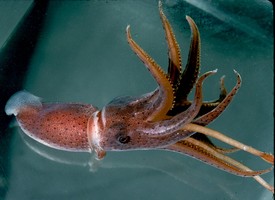
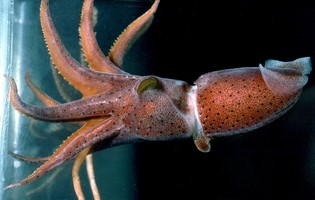
Figure. Histioteuthis oceani, live, Hawaiian waters. Left - Oblique view of right side. Right - View of left side. Photographs by R. Young.
- Photophores
 Click on an image to view larger version & data in a new window
Click on an image to view larger version & data in a new window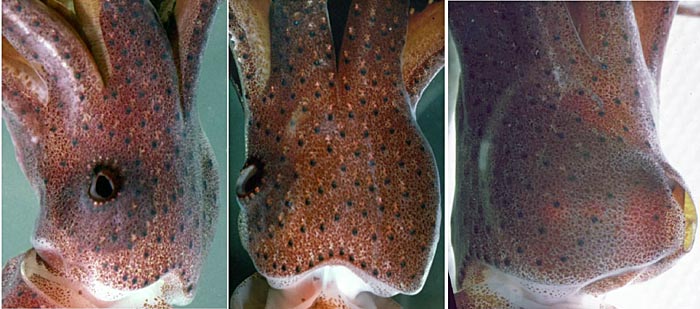
Figure. Right, ventral and left views of the head and arm bases of H. oceani in order to provide an approximate idea of the photophore arrangement, live squid, Hawaii. Photographs by R. Young.
- Compound photophores of uniform, medium size on anterior 3/4 of ventral mantle.
- Compound photophores number usually 16 (rarely 18) around right eyelid.
- Arms IV with 6 longitudinal series on arm base, becoming 5 series beyond the first 1-3 diagonal rows.
 Click on an image to view larger version & data in a new window
Click on an image to view larger version & data in a new window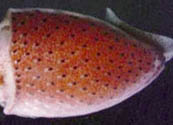
Figure. Ventro-lateral view of the mantle of H. oceani, Hawaii, same live squid. Photographs by R. Young.
 Click on an image to view larger version & data in a new window
Click on an image to view larger version & data in a new window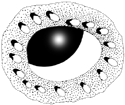
Figure. Lateral view of right eyelid of H. oceani, 50 mm ML, Hawaii. Drawing from Voss et al., 1998.
- Tentacles
- Suckers on manus in 6-7 irregular series; median suckers 1.5-2.0 times larger than ventral marginals.
 Click on an image to view larger version & data in a new window
Click on an image to view larger version & data in a new window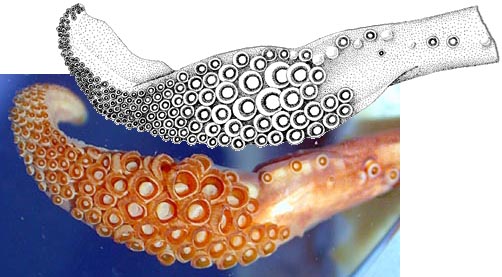
Figure. Oral view of the tentacular club of H. oceani. Top - 50 mm ML, Hawaii. Drawing from Voss et al., 1998. Bottom - 60 mm ML, Hawaii. Photograph of preserved squid by R. Young.
- Suckers on manus in 6-7 irregular series; median suckers 1.5-2.0 times larger than ventral marginals.
- Sucker dentition
- Largest club suckers with numerous acute teeth around entire margins (drawing below right; photograph to the right).
- Large arm sucker rings with 6-10 blunt or square teeth of distal and lateral margins (drawing below left).
 Click on an image to view larger version & data in a new window
Click on an image to view larger version & data in a new window


Figure. Oral views of arm and club suckers of H. oceani. Top - Arm sucker from midarm III (left), largest tentacular sucker (right), both from mature male, 50 mm ML, Hawaii. Drawings from Voss et al., 1998. Bottom - Oral view of large club suckers, 60 mm ML, Hawaii, preserved. Photograph by R. Young.
- Arms
- Subequal; length 120-150% of ML.
- Tubercles
- Ridge of low tubercles beneath epithelium on anterior half of dorsal mantle in midline ; each arm I-III with median aboral ridge of tubercles (arm 1 - 25-36 tubercles; arm II - 23-30; arm III - 17-21). Relative length of tubercle row decreasing from arm I to III.
- Web and buccal crown
- Inner web unites basal 20-30% of arms I-III; outer web slightly developed.
- Buccal crown with 7 supports; supports to arms II undivided.
- Funnel organ
- Unsculptured.
- Unsculptured.
- Fins
- Length 37-43% of ML; width 53-65% of ML.
- Length 37-43% of ML; width 53-65% of ML.
- Spermatophores
- Length 4.0-4.2% of ML; sperm mass 6-8% of spermatophore length (SpL); cement body 58-61% of SpL; ejaculatory apparatus31-35% of SpL and with single long loop. Connective complex well developed with slender, elongate base.
- Hectocotylus
- Sucker stalks on distal fourth of arms I elongate and palisaded. Swollen collars and enlargement of basal suckers absent in single small male examined.
Comments
Other than the photographs, the above description is from Voss, et al. (1998).

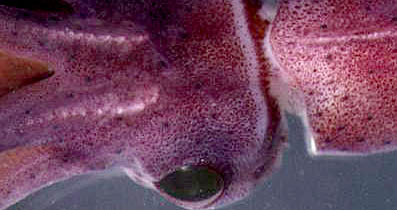
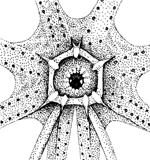





 Go to quick links
Go to quick search
Go to navigation for this section of the ToL site
Go to detailed links for the ToL site
Go to quick links
Go to quick search
Go to navigation for this section of the ToL site
Go to detailed links for the ToL site